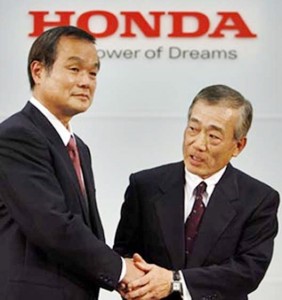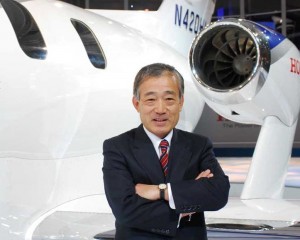
Ito, left, takes over from Fukui this June.
Takeo Fukui, Honda Motor’s President & Chief Operating Officer, will be replaced this summer by Takanobu Ito, a 30-year Honda veteran, it was announced earlier today in Tokyo. Ito, currently Senior Managing Director, will become the seventh CEO of Honda Motor in late June 2009, pending final approval of the board of directors.
The latest results from Japan’s second largest auto maker saw net sales drop globally 16% to 2.533 billion Yen ($1=97 Yen at current exchange rates), and operating income dive 63% to 174 billion Yen in its 3rd quarter of fiscal year 2009 ending last December 31st. Net income compared with same quarter in 2008 declined by an order of magnitude from 200 billion Yen to a mere 20 billion.
Last month Honda reduced its forecast to a full-year profit of 80 billion Yen, and said it would dismiss 4300 temporary workers in Japan. Honda expects to report a loss for the current quarter. And more cutbacks are coming in the U.S. as well.
Still, the company is doing better than its two major Japan-based rivals, Toyota and Nissan. Toyota stock lost half of its value in 2008. And Both Toyota and Nissan have announced they expect to lose money in FY 2009.
Toyota’s announcement in January that family heir Akio Toyoda would be taking over as president this summer as the company faces its first annual lose in more than 70 years was widely viewed as an attempt to instill confidence in financial markets.
Such early announcements of executive changes were once virtually unheard of from Japanese companies. The age of new CEOs also appears to be decreasing by a decade or more from their predecessors. So tactics are changing, given the ongoing global meltdown.
At Honda, Fukui’s six-year tenure was notable for expansion of global manufacturing plants, including the establishment of a U.S. plant in Indiana that builds Civic sedan models, as well as the decision to set up two manufacturing facilities, Yorii and Ogawa, in Saitama, Japan.

Will Fukui's HondaJet fly in the global recession?
Fukui also entered into new business areas, including the establishment of jet engine and aircraft businesses in the U.S., which now looks risky, and the making solar cells, more in keeping with Honda’s green image. The company was talking about global warming and solutions more than a decade ago, long before other auto makers.
Perhaps most notable was the decision under Fukui not to pursue the development and manufactureof full-size pickup trucks and SUVs in North America. This was widely decried at the time as Toyota and Nissan proceeded to do so. It now looks to be a wise choice, as the other two Japanese makers have lost billions upon billions on the trucks. In fact, Nissan will abandoned altogether its Armada SUV and Titan pick-up mid-cycle, intending to replace them with trucks from struggling Chrysler, a strategy that now also looks to be extremely risky.
Honda’s Ito once did a U.S. tour as Executive Vice President of Honda R&D Americas, where he helped develop the Acura brand’s first sport-utility vehicle, MDX, which appeared to great success in October of 2000.
Ito joined Honda in 1978, and began in its automobile research and development operations as an engineer in the area of chassis design. Ito was in charge of developing the all-aluminum, unit-body frame structure for the mid-engine NSX sports car that went on sale in 1990, a first for a volume production vehicle.
In June 2000, Ito was appointed to the Board of Directors of Honda Motor, simultaneously gaining promotion to Managing Director of Honda R&D. He subsequently became President and Director of Honda R&D in June 2003. From April 2009, he will again assume the top position of President and Director of Honda R&D, a title he will retain when he becomes CEO.

I cannot believe that Honda has completely changed it senior management to all Japanese.
What happened?
Do you really want Honda to be closed or non existent in the next 5 years?
The philosophy and the way Honda was made and created is no longer there.
Is very much looking at our competitors, such as Toyota or Nissan, and see what they are doing. Who cares what they doing, Bring back the spirit or the way that Honda should be.
Maybe Soichiro Honda should have lived through to see his own company is going down.
Start employing people outside of Japan and understand that you need different points of view from outsider prospective if you want the company to succeed.
Where is the Honda Sports……? Where is the Honda Energy?
I personally would not be surprise if Honda no longer exists in a few years time.